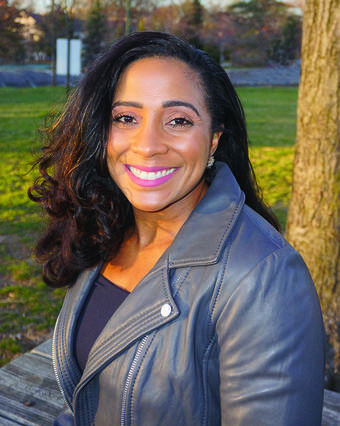By Diane Noserale
U S Geological Survey —
A recent study found that about 30 percent of children drew a female when asked to draw a scientist – an increase from less than one percent in the 1960s and 70s. Are you in the picture?

Celebrating USGS Women
How to Identify a Scientist
While portrayals of scientists as a skinny guy with thick glasses, a bad haircut, and no fashion sense are classic, they no longer fit the bill. Women now are increasingly the ones doing, managing, and running cutting-edge science. Because it’s Women’s History Month, we provide a few examples of successful USGS women scientists who offer advice for anyone interested in a career in the sciences.
Celebrating USGS Women
Dr. Carol Meteyer, Veterinarian, USGS National Wildlife Health Center
As a child, Carol Meteyer loved searching for bugs and other critters in the forests, fields, and streams near her Iowa home. She began her career as a high school science teacher, but really wanted to be a veterinarian.
“Follow the path that’s best suited to you. Work as hard as you can — make a full commitment.”
So Meteyer went back to school and by 1983, she was working in a fast-paced veterinary clinic in Los Angeles. As she diagnosed and treated her animal patients battling cancer, she discovered her love of pathology. The opportunity to begin a residency in comparative animal/human pathology opened a new world of cell structure and patterns that define health and illness in domestic animals, wildlife and humans. Her first pathology job was as an academic pathologist working with domestic animals, but wildlife was her real passion.
“Balancing a full career and a busy family has brought me so much joy I can’t imaging choosing between the two,” said Meteyer. “But there will be challenges, so find activities away from work that you share with supportive friends on a regular basis, and go for it!”
Shortly after her first child was born, Meteyer heard that the USGS (then the U.S. Fish and Wildlife Service) National Wildlife Health Center was looking for a forensic pathologist to determine the causes of disease and death in wildlife. Based in Madison, Wisconsin, this position was her perfect job in a vibrant Midwest town, with plenty of running friends to share the journey.
Meteyer’s work has helped find the causes of serious wildlife diseases. For example, she discovered that white-nose syndrome was caused by a skin fungus that erodes through the wings of bats as their immune system slows during hibernation. She also helped bring a vulture species once common in India back from near extinction. Meteyer and her colleagues discovered that a drug used in cattle before death, was killing the vultures when they fed on the dead livestock. India, Nepal, and Pakistan have since banned the drug and vulture populations are recovering.
“Every job will take whatever you have to give, so pick something you like.”
Meteyer advises that if you’re at odds with others on a scientific issue, “Stop, really think it through. If you still feel the data support your position, persist in a way that your opponents will hear you and defend the science.”
Dr. Virginia Burkett, Chief Scientist, USGS Land Resources Mission Area
As a child growing up in an Air Force family, Virginia Burkett absorbed her father’s culture of service and putting others first. She had few female role models early in her profession. Working for the state of Louisiana, she became the first female state fish and game director in the United States. Her passion for the work impressed her peers. Burkett went on to serve on more than 70 committees, boards, and commissions and publish 95 scientific journal articles, reports, and book chapters.
“Don’t be tentative or underestimate yourself!”
During the 1980s, Burkett was stunned to learn that more than 30 square miles of Louisiana’s coastal wetlands were disappearing every year. This prompted her to carry out one of the first studies on sea-level rise trends and impacts on low-lying coastal areas. Her results provided a basis for mitigation and adaptation at home and in similar areas around the world.
“Don’t hesitate to work on a team.”
Burkett notes that in the 1980s, half of the women at the USGS were part- time workers. As a mother of two, she applauds the flexibility she had to raise children and allow for a work-life balance. In the 1990s, she saw a huge shift with more women earning degrees and positions in the sciences.
Burkett has provided scientific leadership throughout the USGS and beyond. She co-chairs the U.S. Global Research Program and was an author of the first three U.S. National Climate Assessments. She also coauthored four assessment reports for the Intergovernmental Panel on Climate Change, which garnered the IPCC a Nobel Prize in 2007.
Dr. Amanda Demopoulos, Research Ecologist, USGS Wetlands and Aquatic Research Center
Amanda Demopoulos received her Ph.D. in biological oceanography in 2004 and was excited about her coastal mangrove research. However, when the only jobs available were in deep-sea research, she took a USGS position studying animals that live on the seafloor. The job has taken her to deep ocean basins around the world with great colleagues. By accident, she had “landed” her dream job.
“Be open to new experiences.”
“Working on the sea floor is pioneering science. I’m never bored. Every expedition yields new discoveries and sights never before seen by human eyes,” said Demopoulos.
“Passion is critical.”
Recent discoveries offer aspiring scientists great futures, but Demopoulos notes that female scientists weren’t allowed on offshore research expeditions until the mid-1960s. The times have clearly changed for the better, and women now share in all aspects of marine science with their male counterparts.
“Science is interdisciplinary and requires hard work, an open mind, and perseverance. Lean on others in difficult times and seek support when you need it.”
Anne Kinsinger, Associate Director, Ecosystems Mission Area
Anne Kinsinger has held many scientific leadership positions since joining the USGS. Today, she oversees six broadly based programs that provide science to balance the competing demands of resource use and protection. Without a mentor or a Ph.D., she has found her own way.
“Create a reality that works for you — find your own mentor, develop a style that draws on the skills of people around you, or create your own network,” Kinsinger advises.
“Talented scientists get promoted based on their individual accomplishments, but as they move up the career ladder, the things that served them well — being the expert, producing products themselves — become unrealistic in leadership roles,” said Kinsinger. “Leaders need to expand outward, listen to other experts, and be inclusive. They don’t need to know everything and do everything themselves.”
“An open, curious mind, integrity, passion, and respect are keys to success.”
Margo Corum, Associate Program Coordinator, Energy Resources Program
As a youngster, Margo Corum loved playing outdoors with small creatures that lived in the mud. She even asked Santa for a microscope one year so she could zoom in on the tiny creatures.
“Passion and curiosity start at an early age.”
For her first USGS field excursion, Corum found herself in the Everglades wearing waders that were too big and carrying two liter bottles. The alligators made their presence known leaving large tracks in the mud. She pushed on.
“Trust yourself enough to do any job. Don’t overthink it.”
Corum describes herself as a Type-A person who hates making mistakes. At one point, she took on a temporary job detail as an associate science center director. She never bothered to ask how her predecessor operated on one particular task and assumed he did it all himself. It turns out, he delegated some of the work. Sadly, Corum did the work herself and fell behind, learning a valuable lesson.
Her advice for future science leaders, “Learn early on you can’t do it all. Be honest about your capacity and it is acceptable to ask for help.”
Dr. Carolyn Ruppel, Research Geophysicist
As a hard worker, Carolyn Ruppel’s biggest challenge was to have a life not just a career. The path she and her like-minded spouse took isn’t what she advises for others. They spent the first 12 years of their marriage living in separate cities.
Their daughter’s birth “forced the crisis that solved our geographical problem,” said Ruppel. She left a tenured university faculty position for the USGS in Woods Hole, Massachusetts, where she now leads the Gas Hydrates Project, a large project that is shared across two USGS mission areas. She hasn’t looked back. She considers her family fortunate to have found a solution that permits two successful professional careers.
Ruppel was surprised to have many opportunities that might not have been possible without taking a risk and changing fields after finishing her Ph.D. For example, in the years just before joining the USGS, she and an engineering colleague realized that researchers in her field needed special tools to make certain measurements on natural samples at high pressures. Now similar tools are used throughout the field.
“These kinds of opportunities change the course of your career and cannot be anticipated when you are starting out. I never thought I’d have such roles or be able to publish some of the first papers on certain topics.”
More recently, Ruppel thought she would spend the next decade working on methane research in the Arctic. Then she collaborated with NOAA on describing the discovery of hundreds of gas hydrate bubble plumes in the water column off the U.S. Atlantic margin. Consequently, Ruppel has spent most of the last 5 years, and will likely spend the next 5 years as well, focused on this work.
“People skills are as important as technical skills in getting science done.”
So is sticking with it. Many women dropped out because they didn’t have good professional opportunities or had to make hard choices between family and career.
“When things got difficult, I was lucky to be given opportunities to keep going — a new position opened up or the chance to get involved in an important paper. Sometimes, I was chosen based on my potential as a young scientist, not my accomplishments to date,” said Ruppel. “All I had to do was not let setbacks stop me from moving forward.”
“Scientists often experience failure,” Ruppel notes. “The main challenge is not letting many small failures derail your confidence. The key is to remember that even the most successful colleagues have failures, and failures generally become less frequent with time if you stick it out and maintain enough confidence to keep going.”
The USGS is proud to support such a strong cadre of women conducting cutting-edge and world-class science!





















